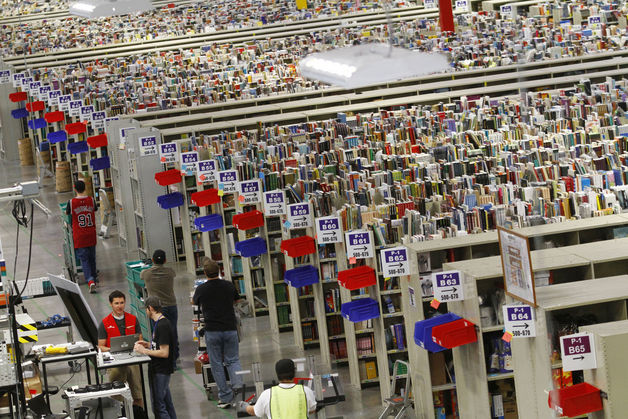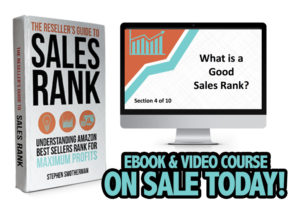You see a super great deal on a Christmas item in January, and you think, “That would be awesome to buy now and sell next November or December! Look at the Keepa graphs… I could double my money easily!”
We’ve all likely been tempted by this buying scenario at one point or another in our Amazon FBA careers. This type of strategy is called the “buy and hold.” You buy an item now, and you hold on to it for a long period of time in anticipation of the price going up enough for you to make a great profit. In the FBA world, “buy and hold” may even mean buying up inventory to keep at your house or storage space for a period of months before sending it in to the Amazon warehouse.
I personally don’t like to use this strategy in my FBA business, and I’ll tell you my top three reasons why in the rest of this blog post.
-
 It’s a risky strategy.
It’s a risky strategy.
Running a business inherently comes with some risk. It’s unavoidable. But as a business owner, I want to be able to pick and choose the types of risk I take on for my business and the types I want to avoid. To me, buying and holding inventory that doesn’t have a guarantee of selling for a profitable price is just not the type of risk I like to take on.
Sure, you can look at the Keepa graphs for an item and see what that item might sell for on Amazon several months down the road, but it is less risky to buy items that Keepa tells you will likely sell quickly for a good profit. I would much rather invest my money in inventory that is going to sell sooner rather than later.
-
 Storage costs can be expensive.
Storage costs can be expensive.
If you’re selling via FBA, you need to figure in the cost of storage fees when you’re deciding how long you’re willing to hold an item before it will likely sell. If you send an item to the FBA warehouse, Amazon is going to charge you a monthly storage fee, and after 12 months of storage you also incur long-term storage fees.
You also need to factor in the impact on your IPI score if you want Amazon to store your inventory long-term. Amazon looks at your excess inventory (inventory that’s not expected to sell within a short time frame) and your sell-through rate (how quickly you are selling your inventory and replenishing it with new stock) when they determine your IPI score. If your IPI (or inventory performance index) is too low, Amazon may limit the amount of space you have available to your business at their FBA warehouses, which would severely impact your business.
 Rather than sending those long-term holds to Amazon, some sellers might decide to just keep the inventory at their house, in the garage, in the closet, or in a storage unit. That’s a personal choice, but again it’s a choice I wouldn’t make because of the impact it has on my business and my life.
Rather than sending those long-term holds to Amazon, some sellers might decide to just keep the inventory at their house, in the garage, in the closet, or in a storage unit. That’s a personal choice, but again it’s a choice I wouldn’t make because of the impact it has on my business and my life.
Honestly, I used this method in years past, but it was a pain for me to keep up with when I needed to send that inventory in to Amazon in order to make a profit. Out of sight, out of mind, and when I did finally find those long-term holds in my closet or the corner of the garage, the window of opportunity had passed and the inventory was no longer profitable on Amazon anyway. At this point in my life, I just don’t want to use up valuable space in my home or storage unit storing things that might not ever bring me profit, and I don’t want to use up valuable mental energy keeping track of those long-term holds.
-
 Opportunity costs are too high.
Opportunity costs are too high.
A simple definition of “opportunity costs” is the opportunities you lose out on because you make a certain decision. Most decisions come with tradeoffs. If you decide to do A, you’re going to miss out on B or C. You just need to weigh whether or not you think A is valuable enough to give up B or C in order to get it.
I’ll give you an example of opportunity costs through the story of Bill and Betty. Bill views himself as a forward-thinking kind of guy. He sees some toys that he wants to buy now and hold on to for a year and sell at a higher profit several months down the road. The toys are only $10 now, but in a year the company will no longer be making that toy set and retail stores will run out of them. He figures that $10 toy set will be worth $50 or $100 in a year or two. Now, I like the thought of turning $10 into $100 just as much as Bill does…but what is Bill losing out on if he invests in that $10 toy set and puts it in his closet to just sit there for a year or two?
 Betty, on the other hand, understands how opportunity costs work. She understands that she could take that same $10 and invest it in inventory that will likely sell much quicker and bring her profits in a shorter period of time. Once she gets her profits back, she can reinvest her original $10 plus her profits in fast-turning inventory and make even more profits, that she can then reinvest over and over and over again. Betty plans to make a snowball of profits out of her original $10, and she could potentially make $1000 in the same time that Bill is still waiting for his toy set to possibly maybe (but not likely) be worth just $100.
Betty, on the other hand, understands how opportunity costs work. She understands that she could take that same $10 and invest it in inventory that will likely sell much quicker and bring her profits in a shorter period of time. Once she gets her profits back, she can reinvest her original $10 plus her profits in fast-turning inventory and make even more profits, that she can then reinvest over and over and over again. Betty plans to make a snowball of profits out of her original $10, and she could potentially make $1000 in the same time that Bill is still waiting for his toy set to possibly maybe (but not likely) be worth just $100.
Opportunity costs could make or break your business. You need to be thinking through all of the factors in these three scenarios (storage fees, risks, opportunity costs) before you make your buying decisions.
Have you seen the benefits of using a snowball of profits to grow your Amazon FBA business over time? We would love to hear from you in the comments if you have an encouraging story to share!
![]()
 Sales rank is easily the most misunderstood aspect of selling on Amazon. What is a good sales rank? What does a sales rank of zero mean? What do I do with sales rank for sub-categories? Why does sales rank have to be so confusing so much of the time?
Sales rank is easily the most misunderstood aspect of selling on Amazon. What is a good sales rank? What does a sales rank of zero mean? What do I do with sales rank for sub-categories? Why does sales rank have to be so confusing so much of the time?
I’m here to tell you it doesn’t have to be that way! You can finally get the clarity you need on the issue of understanding Amazon sales rank numbers. We at Full-Time FBA have launched a mini-course called The Reseller’s Guide to Sales Rank: Understanding Amazon Best Sellers Rank for Maximum Profits. The mini-course is a combination ebook (30+ pages) and video course (almost 2 hours).
Check out The Reseller’s Guide to Sales Rank mini-course to see how you can master the concept of best sellers rank and be on your way toward smarter sourcing decisions for your Amazon FBA business!

I do a little bit of ‘Buy and Hold’ on things that I am pretty certain will sell for exponential gains, but not enough to kill my budget etc. I will only do that if the price is ridiculously low (at 90% off or so), but I won’t do it with iffy items or marginal pricing. Don’t tie up good capital or storage just as Stephen says.
This article is very timely for me because I’m entering toys, a new category for me and realize that the buy and hold strategy is very common. Since last night, I’ve been thinking about what that will mean for me as an FBA seller but your post today has just made everything so much clearer for me. Think about the opportunity cost and what else I could be doing with the money invested in buy and hold products. Thanks Stephen and Rebecca for creating a wonderful community and producing relevant articles. God bless you.
Great article! I have some inventory I am holding because I got it at Walmart and my seller app said I could sell it, but when I got home, I found this was not true and I could not list it. I have been hanging on to it for weeks now, tripping over the box daily, and this weekend I am just going to return it!!
Wish I had seen this before I bought close to 700 items in May thinking I was going to make a big return, but after I bought them, the price that the 1 seller on it had went down $6 and then Amazon listed on it too. It is becoming a money pit with monthly fees for storage. Luckily, I can bring them all back and have started to, but keep thinking they will probably start selling by the time I bring them all back and will have to pay to send them back in again. Should have done more thorough due diligence! Expensive mistake!